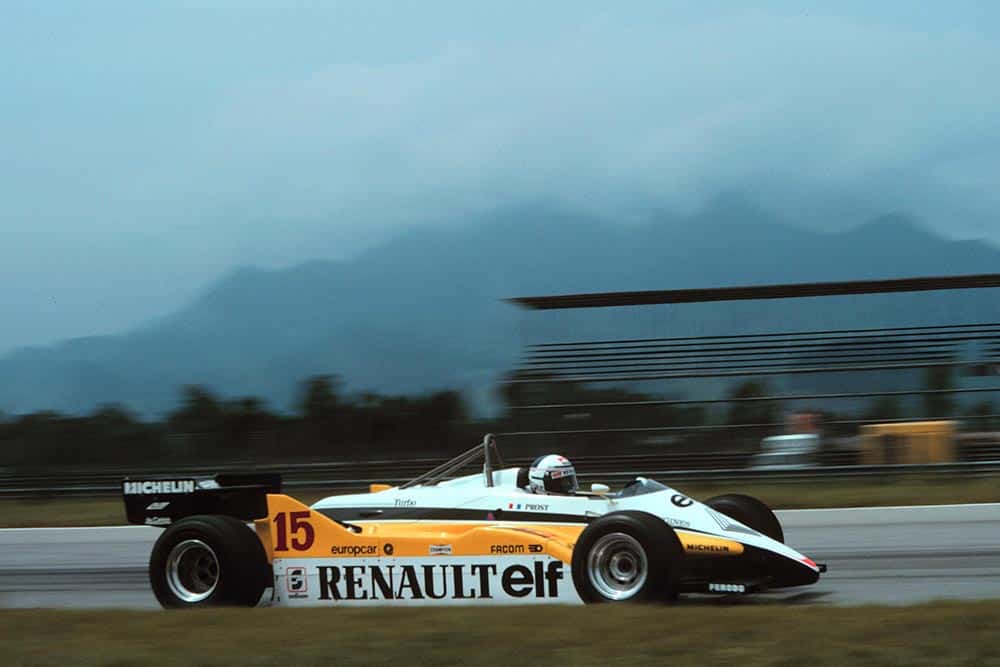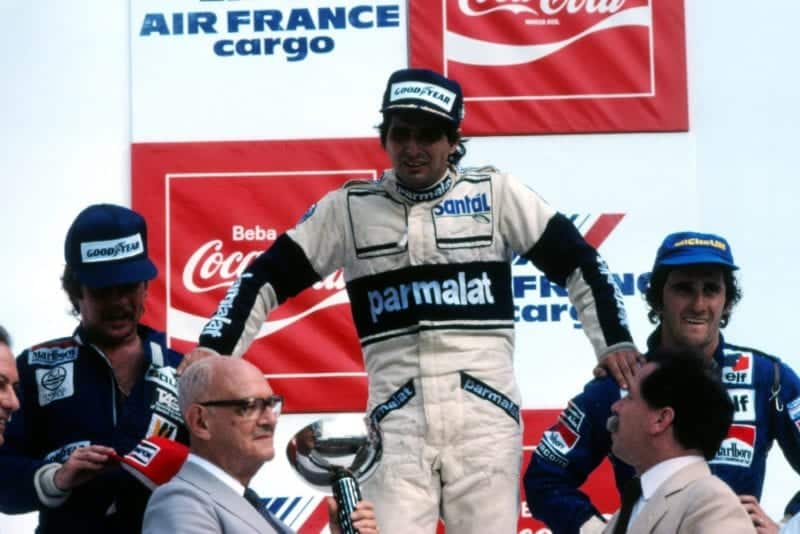1982 Brazilian Grand Prix race report

Alain Prost inherited the win after Nelson Piquet and Keke Rosberg were disqualified
Motorsport Images
Home win
Rio de Janeiro, March 21st
TO WIN one’s home Grand Prix is the ambition of every Grand Prix driver and the success is even sweeter if that competitor happens to be a World Champion performing on home soil for the first time since winning his title. So this year’s Brazilian Grand Prix, held over 63 gruelling, extremely hot laps of the Autodromo Riocentro, was a very special day indeed in the career of reigning Champion Nelson Piquet. To the unconcealed, hysterical delight of thousands of his car-crazy compatriots, Piquet struggled home a totally exhausted winner at the wheel of his Brabham-Cosworth BT49D. In the words of second place finisher Keijo Rosberg, whose Williams FW07C was just under 12 sec. adrift at the finish, Piquet’s performance “was a triumph of mind over matter — nothing but sheer will power”. For Nelson Piquet was absolutely exhausted, dehydrated and drained: just as he had been at Las Vegas last October when he clinched his title. But he squeezed every last ounce of determination out of himself, so much so that he actually collapsed with fatigue on the winner’s rostrum.
Piquet’s victory at Rio came at the end of an absolutely splendid motor race, an event which thankfully eclipsed much of the political and technical controversy which is hampering the Formula One business these days. In South Africa we had the drivers’ strike and in Brazil we were faced with the problem of “disposable ballast”. In an attempt to get their normally aspirated cars back on terms with the very powerful V6 turbocharged machines from both Renault and Ferrari, the FOCA teams had decided on a very liberal interpretation of the rules concerning minimum weight. Most of them decided to adopt reservoirs (plastic bottles, actually) in which to store water for brake cooling purposes, topping these up after the race to bring the car back to the official 580kg minimum weight limit. Of course, once the race got under way this coolant quickly evaporated as it is blown into the brake cooling ducts with the result that most of the normally aspirated cars spent a large part of the race running under weight. As I say, it was a liberal interpretation of the regulations, although to talk to FOCA team managers you would think that it was a perfectly acceptable loophole in the rules which nobody in their right mind should question. Of course, neither the Ferrari nor Renault teams accepted this point of view and, from the start of practice, it was made very clear that the two major manufacturers would be lodging a formal protest in the event of a FOCA “featherweight” winning the race.
Qualifying

Jean-Pierre Jarier qualified his 23rd
© Motorsport Images
Practice for the race took place in muggy, oppressively humid conditions and the bumpy track surface brought forth many complaints from the drivers who were quite clearly having a very tiring time indeed with the current breed of Grand Prix car which offers virtually no suspension movement at all to cushion the bumps. Most drivers were wearing neck supports in an attempt to minimise the effects of G-forces on the fast, slightly banked corners which abound on this anti-clockwise circuit and several had pipes rigged up within the cockpits to blow oxygen either into their helmets or overalls to make life a little more bearable.
With only two sets of qualifying tyres permitted for each driver it was a question of cramming in a clear lap without being baulked by a slower car. But at the end of the day the grid had a fairly acceptable look about it with no obvious anomalies. Pole position taken in Alain Prost’s almost clinically efficient style, the little Frenchman taking his Renault RE36B round in 1 min. 28.808 sec., over six seconds faster than Piquet’s pole position time last year in the Brabham BT49C. In the final session Gilles Villeneuve got to grips with his heavy Ferrari 126C2 in fine style, upholding Goodyear’s honour to claim second place on the grid, although the French Canadian knew full-well that he would have to use harder tyres than either Williams or Brabham when it came to starting the race itself on full fuel tanks.
René Arnoux had a troubled time with his Renault, going off the road twice during practice, once when the rear wing support broke and later simply due to over-exuberance. He could only manage a 1 min. 30.121 sec. lap to take fourth place and had to give best to the fastest normally aspirated car, Rosberg’s Williams FW07C which recorded a very respectable 1 min. 29.358 sec. to line up immediately behind Prost on the starting grid. It was a first class effort by the enthusiastic Finn and eclipsed the fifth and sixth qualifiers who were Niki Lauda (McLaren MP4B) and Carlos Reutemann (Williams FW07C). The Brabham team had put aside its turbocharged BMW-engined BT50 for this race, preferring to concentrate on Gordon Murray’s latest update of the successful BT49-Cosworth theme. The latest BT49Ds were brand new cars for World Champion Piquet and Riccardo Patrese, very much lighter than their ‘C’ specification predecessors and both fitted with such exotic refinements as carbon fibre brake discs which were being used by the team for the first time since Silverstone last year. Piquet didn’t manage to find a clear lap and qualified an uncharacteristically lowly seventh on 1 min. 30.281 sec. with Patrese ninth, the two Brabhams split by Didier Pironi in the second of the Ferrari 126C2s.

Niki Lauda qualified 5th on his return to Grand Prix racing
Motorsport Images
The smart new Alfa Romeo 182 attracted a great deal of favourable comment and Andrea de Cesaris kept out of trouble to qualify the new V12 machine tenth, just in front of Elio de Angelis’s new Lotus 91. John Watson was complaining about excessive understeer with his McLaren MP4B while Nigel Mansell had a couple of off-circuit excursions in his Lotus 91, the first when the bodywork came loose and the second when the car jumped out of fourth gear. Later the crownwheel and pinion had to be replaced which meant that Mansell had to spend some time in last year’s 87 on Saturday morning, this being the team’s spare car.
In the middle of the grid there were no real surprises, but Alboreto went well with the Tyrrell 011 to qualify 13th and Winkelhock put his ATS D6 into 15th position, well ahead of his troubled team-mate Eliseo Salazar. Raul Boesel outqualified the much more experienced Jochen Mass in the March team while Baldi qualified his Arrows and Henton didn’t. Right at the back of the grid were Laffite and Cheever, both frustrated that their relatively heavy Talbot-Matra JS17s offered little scope for joining in the disposable ballast game. “Running water bottles?”, said Laffite incredulously, “we can’t even get down to the weight limit let alone need a way of ballasting up to it!”
The start was absolutely magnificent with Villeneuve surging into the first left hander ahead, Rosberg coming through sitting it out with Arnoux’s Renault to snatch second place, and Prost getting away slowly. Down through the twisting section on the outward leg of the circuit Rosberg tried to get to grips with the leading Ferrari and even attempted to run round the outside at the hairpin which leads onto the back straight. He ran wide and the two Renaults of Arnoux and Frost immediately surged past.
Race

The race gets underway
Motorsport Images
Villeneuve completed the opening lap at the front of a wobbling, darting convoy of cars and most people simply thought that the brave Ferrari driver was simply out for a short-lived, “banzai” morale-booster at the front of the field. The Ferrari was surely too heavy on full tanks and the more agile Cosworth runners in his wake would quickly outfumble him. But nothing seemed further from the truth. Villeneuve settled swiftly into a rhythm and began to edge away from Arnoux while the Brabhams of Patrese and Piquet quickly darted through the pack to take up station in third and fourth position. Prost’s Renault was suffering from a slight high speed misfire and he was unable to get on terms with the leaders, so he was a few lengths further back ahead of a great steaming mob in which de Cesaris’s Alfa Romeo was featuring quite prominently, Lauda, Watson and Reutemann both keeping a close watch on the Italian driver with an air of cautious restraint. In the middle of the field the incidents came fast and furious. Daly’s new Theodore and Boesel’s March bumped each other, the Brazilian eventually flying off the track when the suspension broke as a result. Daly later spun and was unable to restart.
Cheever’s Talbot was an early casualty with a water leak, team mate Laffite battled with a broken skirt and a misfire, eventually packing it in after a pit stop, and de Cesaris’s brief spell in exalted company finished when he rode over a kerb and dislodged the Alfa Romeo’s one-piece underbody panel. He crawled into the pits to retire leaving Reutemann leading Prost’s pursuit in seventh place. Lauda slipped past the Williams and then Watson made his way past both of them. Reutemann then proceeded to dive inside Lauda under braking for the corner before the pits, misjudged things and slid into the McLaren, bending its right rear suspension. While Reutemann went on to eliminate himself and Arnoux’s Renault in a similar incident, both cars ending up in the cards fencing, Lauda trailed round to retire.
Eventually the contest for the lead fell into the hands of Villeneuve, Piquet and Rosberg, both the Cosworth engined cars swapping places frantically a few lengths behind the confident looking Ferrari. This was the first time that Rosberg had been in such top-class company and he was driving with a great deal of spirit, racing confidently with Piquet although the Brabham was much quicker on the straight than his Williams. Unfortunately his enthusiasm to compete meant that he was rather hard on his tyres and that was to guarantee he would not be able to challenge Piquet towards the end of the race.
Little by little Piquet worked his way closer to the leading Ferrari. Villeneuve’s tyres were wearing badly and he was having to womb increasingly hard to stop the Ferrari in the tight corners. On lap 30 it was clear that little Nelson was going to have a try at getting past and be pulled alongside the Ferrari, on the outside, going into the left hand hairpin before the back straight. Villeneuve tried to sit it out with him, got the Ferrari’s left hand wheels on the dirt, slid onto the grass and then pirouetted across the track into the opposite guard rail right in front of Piquet. The Brazilian was lucky to avoid him, but it was the decisive moment of the Brazilian Grand Prix.

Piquet is supported on the podium by Rosberg (left) and Prost
© Motorsport Images
For the next 33 laps the contest evaporated into a procession. Piquet, struggling against fatigue, made it to the finish to score a most impressive victory, even though he subsequently collapsed on the winner’s rostrum. Rosberg was a game, happy second while Prost, Watson, Mansell and Alboreto all survived the pitfalls and problems to complete the first half dozen. While Nelson Piquet was being revived by the side of the winner’s rostrum, he probably didn’t see Prost’s amused grin. But at least the winner could be satisfied that he had lasted the course: his team mate Patrese had to give up and retire, almost unconscious with exhaustion long before the finish. — A.H.
